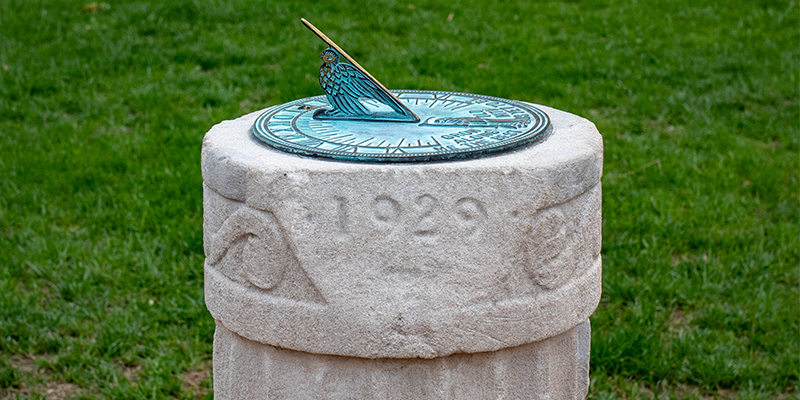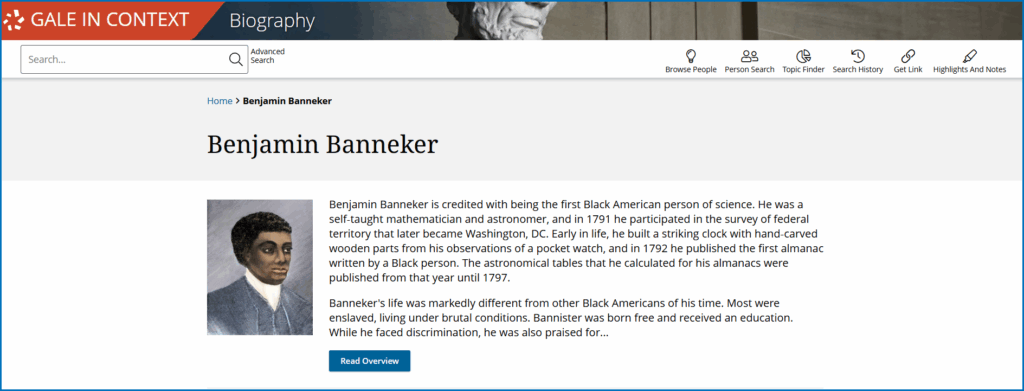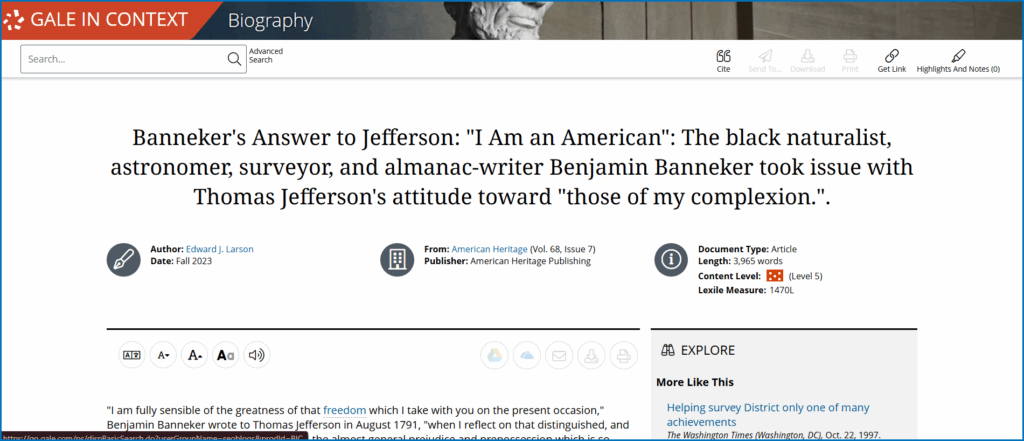|By Gale Staff|
Benjamin Banneker was born free in 1731 on a small tobacco farm in Maryland. Although his classroom education lasted only a short time, he continued learning on his own, relying on borrowed books and his diligence in observation to cultivate a lifelong study of mathematics and science. At a time when many claimed such pursuits were beyond the reach of those in the black community, Banneker’s work stood as clear evidence to the contrary.
Benjamin Banneker Week, observed November 12–18, can serve as an inspiration for students—a reminder that their circumstances do not define their potential and that the skills they develop in the classroom can lead to history-making contributions.
Gale In Context: Biography offers resources detailing the fascinating achievements of Banneker’s life, from his groundbreaking work as a self-taught mathematician and astronomer to his early documentation of insect periodicity, including the 17-year life cycle of the cicada, one of the first such records in America.
Listen to Morning Edition’s broadcast on Banneker’s work with cicadas.
Banneker the Clockmaker
Benjamin Banneker’s first major project was to build a clock—an extraordinary undertaking in colonial America, where timepieces were very rare. Those that existed were imported from England and made of metal. Banneker, however, constructed his almost entirely out of wood.
In 1751, the 21-year-old mathematician borrowed a pocket watch from an acquaintance named Josef Levi, taking it apart to study and diagram the complex gear and cog components. Over the next two years, Banneker worked out the ratios that governed the turning of its gears and scaled those calculations into wooden parts he carved by hand. Every tooth on every gear had to be cut in the correct proportion so that the pendulum’s swing would divide time evenly into minutes and hours.
His work was America’s first striking clock, one that chimed the hour as it kept accurate time for the next 40 years. News of the invention spread quickly through Baltimore County, and visitors came to the Banneker farm to see the wooden mechanism in operation.
Banneker the Astronomer
Banneker’s scientific work grew directly out of his mathematical expertise but expanded into sustained observation of the natural world, with astronomy as his primary focus.
When Banneker inherited his family’s Baltimore farm in 1759, he continued to study on his own, relying on his books and observations. However, it was not until the Ellicott family moved into the area in 1771 and established a gristmill, that Banneker found a true intellectual community.
George Ellicott, a Quaker land surveyor with a passion for astronomy, quickly befriended Banneker. The Ellicotts’ support helped Banneker pursue his fascination with studying the sky.
Charting the Heavens
In 1788, at the age of 57, Banneker began his serious study of astronomy, aided by books and lunar tables lent to him by George Ellicott, including James Ferguson’s Astronomy Explained Upon Sir Isaac Newton’s Principles and Tobias Mayer’s Lunar Tables.
With these resources, a borrowed pedestal telescope, and his own observations, Banneker began to master celestial calculation.
His first prediction that gained national recognition was that of the April 14, 1789, solar eclipse visible in the mid-Atlantic. This feat required Banneker to use spherical trigonometry—a branch of mathematics that uses the geometry of spheres to predict the positions of heavenly bodies. The eclipse arrived on schedule, proving his figures to be correct.
Two years later, he compared his calculations for the April 3, 1791, annual solar eclipse with those of Ferguson, one of the authors whose books set him on the path to his celestial aspirations. Ferguson’s tables placed the event about 32 minutes early, while Banneker’s timing aligned more closely with the event as it actually occurred.
For intellectuals of his time, Banneker’s eclipse predictions were a visible confirmation that his figures were painstakingly well-calculated and—in this case—more dependable than those produced by professional astronomers with far greater resources.
Banneker the Publisher
The confidence Banneker gained from his work on the eclipse led him to attempt a more ambitious project: compiling a complete ephemeris, or a yearly record of celestial motions. Beginning in 1791, Banneker set out to calculate the daily positions of the Moon, Sun, and planets, as well as to predict upcoming eclipses and prepare tide tables for the mid-Atlantic region.
Banneker worked by hand, running numbers, then re-checking them against his nightly observations and compiling them into tables that others could reference. The process was slow and exhausting, but the accuracy of the finished pages reflected his persistence.
His labor bore fruit in the form of Banneker’s Pennsylvania, Delaware, Maryland, and Virginia Almanack and Ephemeris for the Year of our Lord 1793. Alongside the usual data—weather, planting guides, tide tables, eclipses, phases of the Moon, and planetary positions—Banneker offered more mystical insights, as was the fashion of the time. Readers would look to these reference books for astrological guidance on which days would be auspicious or unlucky and vivid retellings and interpretations of his dreams.
The almanac secured Banneker’s public reputation as a skilled mathematician and scientist, challenging the prevailing ideas of his time about the limits of intellectual capacity of African Americans.
Advocacy in Print
By the 1790s, the United States was a nation founded on the promise of liberty, yet it was still sustained by slavery. Defenders of the institution often argued that black people lacked the intellect for full citizenship. Banneker understood that his scientific work gave him standing to challenge those assumptions, and his almanac became a platform for that advocacy.
In August 1791, Banneker sent a manuscript of his 1792 almanac to Thomas Jefferson, then Secretary of State, along with an accompanying letter. Jefferson had publicly speculated that black people were inherently inferior, but Banneker’s tables of eclipses and planetary positions stood as a tangible refutation.
He reminded Jefferson of the prejudice against people of his race and how they had “long laboured under the abuse and censure of the world . . . considered rather as brutish than human, and scarcely capable of mental endowments.” He then pressed Jefferson to reconcile the Declaration’s claim that “all men are created equal” with the realities of slavery.
Jefferson replied on August 30, 1791, with a brief but courteous note, writing that “No body wishes more than I do to see such proofs as you exhibit, that nature has given to our black brethren, talents equal to those of the other colours of men.” He acknowledged Banneker’s almanac as evidence of that ability and forwarded it to the French Academy of Sciences through its secretary, Marquis de Condorcet.
The letter sounded generous, but in reality, Jefferson continued to enslave more than 600 people over the course of his life and never acted decisively to end the institution. Anti-slavery advocates at that time, however, recognized the power of the exchange. Printers reissued the correspondence alongside Banneker’s tables, most notably in the Baltimore edition of his 1793 almanac.
Banneker the Surveyor
In 1791, President George Washington authorized the creation of a new federal district to serve as the nation’s capital. Congress approved a ten-mile square on the Potomac River, and the plan was to mark its edges with boundary stones placed at one-mile intervals. The responsibility for the survey fell to Andrew Ellicott, cousin of George Ellicott.
Before his crew could begin setting those stones, however, they needed fixed reference points in the sky. Banneker, then 59 years old, was the natural choice for the job.
His task was to determine the site’s latitude and establish true north by observing the positions of stars. To do that, he had to synchronize the surveyors’ clock with astronomical time, so that the precise moment a star crossed the meridian could be matched to a reading on the instrument. With north-south and local time fixed, the surveyors could then extend lines outward, confident their measurements would stay accurate across the entire ten-mile diamond.
Banneker’s time on the project was relatively brief—about three months, from February to April 1791—but in that time, he supplied the astronomical data that anchored the survey of the new capital. It was an extraordinary role for a free black man in an era when most people of color were excluded from scientific and civic life.
Today, many of the original sandstone boundary markers still stand along the edges of the District of Columbia, a visible reminder of the precision work he contributed at the city’s beginning.
Celebrate Benjamin Banneker’s Trailblazing Legacy This November
In 1791, during Banneker’s work on the federal survey of the new capital, the Georgetown Weekly Ledger published this quote: “[Ellicott] is attended by Benjamin Banneker . . . whose abilities, as a surveyor, and an astronomer, clearly prove that Mr. Jefferson’s concluding that race of men were void of mental endowments, was without foundation.”
This public acknowledgment of his achievements pushed back against assumptions about who could master science and mathematics, and his life became a rebuttal to the idea that background dictates ability. Such high praise predicted the stature Banneker would come to hold as a symbol of black ingenuity and intellect in the earliest days of the United States.
Your students can explore the remarkable life and contributions of Benjamin Banneker, as well as those of other pioneering black scientists and mathematicians, with Gale In Context: Biography. The platform is a reliable, classroom-ready resource for detailed biographies, primary sources, modern insights, and multimedia content on figures like George Washington Carver, Mae Jemison, and St. Elmo Brady, whose work has inspired countless others in their fields.




